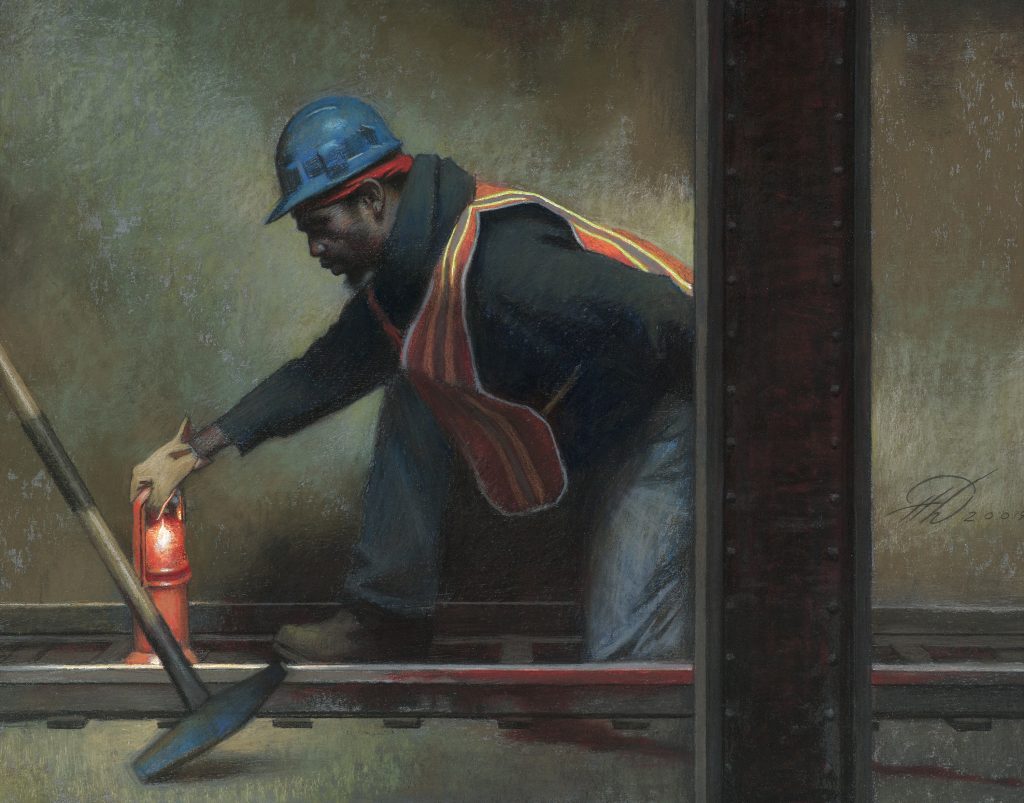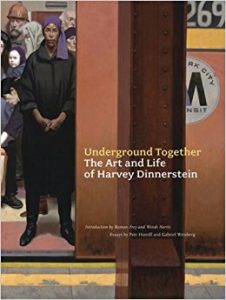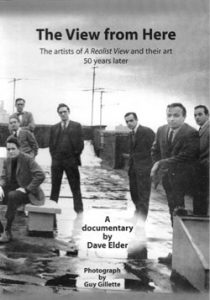What does an “Underground Drum Beat” look like? Maybe you’ve heard that sound at an MTA station once or twice, so the phrase might strike a familiar chord, and you might also have an associated visual image. Your personal vision may or may not match the 2014 Harvey Dinnerstein painting which goes by that name, but even if it doesn’t come close, the scene depicted will probably remind you in some way of your own underground experiences.
For virtually all of his lengthy artistic career, Harvey has drawn inspiration from the NYC subway mayhem, even literally drawing many fellow riders with his pen and sketch pad, so it would seem fitting that at the Gerald Peters Gallery on 78th Street in Manhattan, the 2 Dinnerstein works included in their current show called “American Realism: A Survey” are the previously mentioned “Underground Drum Beat” and a piece titled “Blood on the Tracks” which obliquely pays tribute to a track worker that Harvey knew personally.

 Not so coincidentally, HD also has a 2008 book entitled “Underground Together” which includes a number of memorable subway portrayals. Of course, the book has plenty of paintings and drawings about other subjects, and Park Slope residents will almost certainly recognize at least one or two local landscapes on its pages. Dinnerstein’s fascination with the MTA, though, makes perfect sense in light of the vast array of visually-diverse straphangers who push the turnstyles every day. Where else could a realist figurative artist hope to find such an extensive gathering of unique and intriguing models?
Not so coincidentally, HD also has a 2008 book entitled “Underground Together” which includes a number of memorable subway portrayals. Of course, the book has plenty of paintings and drawings about other subjects, and Park Slope residents will almost certainly recognize at least one or two local landscapes on its pages. Dinnerstein’s fascination with the MTA, though, makes perfect sense in light of the vast array of visually-diverse straphangers who push the turnstyles every day. Where else could a realist figurative artist hope to find such an extensive gathering of unique and intriguing models?
Harvey regularly took the train from Brooklyn to Manhattan, and back, on school days when he attended the High School of Music and Art during the 1940s. As a high school student, he and a few like-minded friends with an interest in realism formed a small “rebel” group, rarely finding encouragement among the modernist orthodoxy shared by the majority of teachers and pupils.
A bit later, in early 1961, Dinnerstein and his rebel “realist” friends, along with a few other artists who had similar perspectives, presented a show called “A Realist View” at the National Arts Club in Manhattan, as a statement to fellow artists, and anyone else drawn to visual art, about their ongoing exploration of representational depiction, and their insistence on the validity of that pursuit. At the time, the art world did not welcome a message that ran contrary to the widely-accepted axiom of modernism as the sole form of legitimate artistic expression, and the presentation did not create the kind of ripple that the presenters had hoped, but each and every one continued to follow realism wherever it would lead them.
For the 3 surviving members of that 1961 show — Burt Silverman, Daniel Bennett Schwartz, and Harvey — their efforts to give meaning to traditional visual portrayal techniques in a modern context continue, and over time, their work has attracted some well-deserved attention.
 The Gerald Peters Gallery show runs from May 18 to June 16, and you can check out Harvey’s drum beat painting at http://www.gpgallery.com/exhibitions/american-realism-a-survey#22, with more info about the gallery at http://www.gpgallery.com/gallery. To find out more about Dinnerstein’s book “Underground Together” and the artwork it contains, a YouTube video about it at https://youtu.be/FOYEmSjOJbs gives a pretty good sketch. In addition, a 2011 movie called “The View From Here” tells much of the story about the group of artists who presented “A Realist View” in 1961 and their art, and you can find information about that film, including an Amazon link to view it, at http://theviewfromheredoc.com/.
The Gerald Peters Gallery show runs from May 18 to June 16, and you can check out Harvey’s drum beat painting at http://www.gpgallery.com/exhibitions/american-realism-a-survey#22, with more info about the gallery at http://www.gpgallery.com/gallery. To find out more about Dinnerstein’s book “Underground Together” and the artwork it contains, a YouTube video about it at https://youtu.be/FOYEmSjOJbs gives a pretty good sketch. In addition, a 2011 movie called “The View From Here” tells much of the story about the group of artists who presented “A Realist View” in 1961 and their art, and you can find information about that film, including an Amazon link to view it, at http://theviewfromheredoc.com/.
